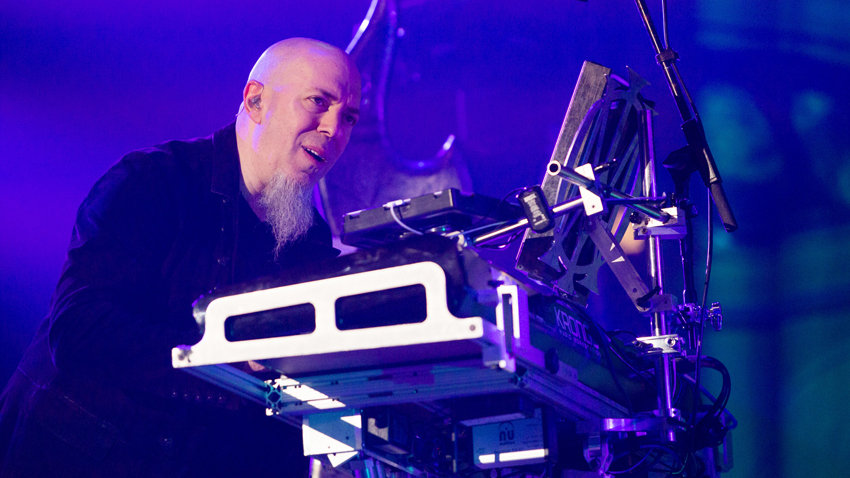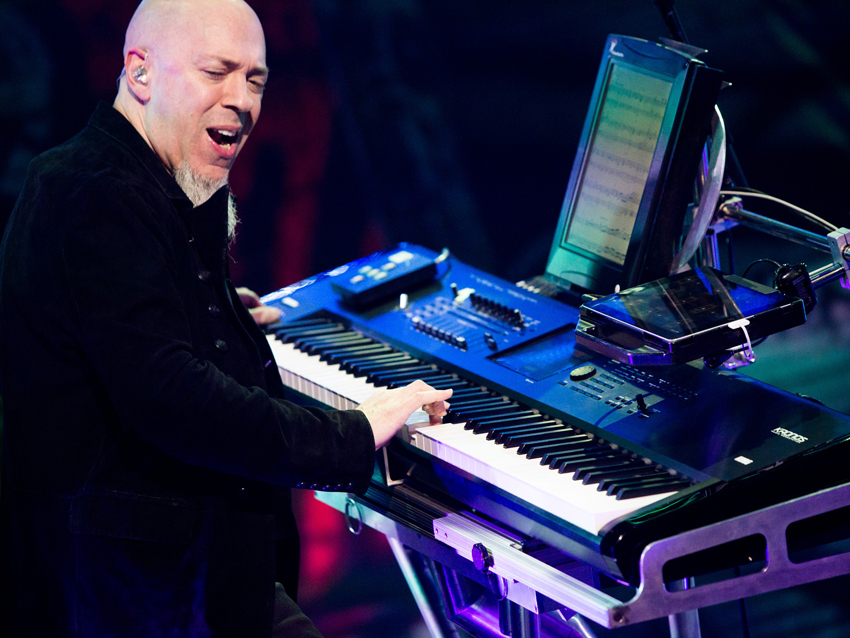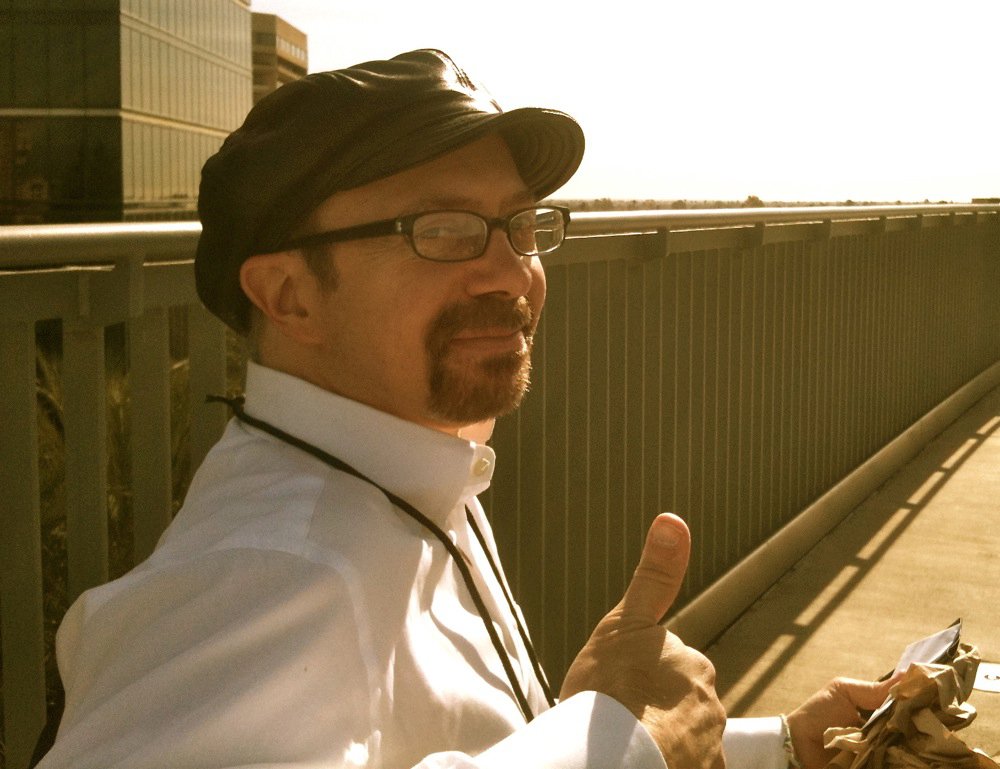
"It's a big, big show," says Dream Theater keyboard titan Jordan Rudess of the band's Along For The Ride tour (also called "An Evening With Dream Theater"), currently powering its way through Europe before hitting North America on March 20. "We're doing three hours with no opening act. It's the biggest show the band has ever done. With all the music and the visuals, it's a total journey and a real experience."
The progressive-metal kings have been treating audiences to a generous portion of their self-titled 2013 album, including the epic 22-minute disc-closer Illumination Theory, as well as readings of songs from Awake (celebrating its 20th anniversary) and Metropolis, Part 2: Scenes From A Memory (released 15 years ago).
Calling from Copenhagen, Rudess talked to MusicRadar about the setlist, how he prepares for a three-hour onstage workout and the changes he's made to his keyboard setup since the band last tour in 2011.
You're using False Awakening Suite from the new album as your intro music. That's a first - in the past, you've come onstage to theme scores from films.
"Right, exactly. That was the plan. John Petrucci and I were talking about how we've always used these grand, over-the-top classical pieces, and we just decided, 'Hey, we can write something by ourselves.' So we did."
How did you rehearse privately for this tour? I imagine you do a lot of work on your own before you get in a room with the other guys.
"That's true, I do. So much of what goes into this involves lots of pre-production at home. One of the reasons is because my approach in the studio is very different than live. When I'm in the studio, writing music and recording, I use all sorts of hardware synthesizers and software synthesizers, and anything is fair game. If it's a noisemaker and I want to use it, I'll give it a go. [Laughs] I love to have fun and explore and try some new things.
Want all the hottest music and gear news, reviews, deals, features and more, direct to your inbox? Sign up here.
"With all of that, though, is the reality that we have to take this stuff on tour. I try to keep my live rig fairly simple, and right now most of my sound is coming from my Korg Kronos X. What that means is that I have to do a lot of work to figure out how to take not only all the sounds but also all the tracks that I play, because I might have layered a string patch, then I did a brass part or a choir, or maybe I did some other kinds of effects. It's a big job to figure out what I played and then how to put squeeze it all into my Kronos.
"It's a long process that I do on my own. Sometimes I'll go back and sample stuff if I literally need to get a particular sound, or I'll re-create it using the synthesis parameters in the Kronos. I'll have things where my pinky is playing a cello line and my thumb is playing the French horn line; my right hand might be layering a choir and brass, and on the lowest two keys of the keyboard there might be a sound effect I'm triggering. A lot of stuff all at once."

On stage at Palalottomatica in Rome, Italy, January 22, 2014. © Daniele Rotondo/Demotix/Corbis
At what point do you start working with your tech on pre-tour prep?
"I really do all the sound programming by myself, but I do have people helping me when I'm at home in my studio. If I need to do a sampling session, I'll bring out one of my techs - we'll do it together. But the reality is that it comes down to me sitting in front of my equipment and just making it happen, because nobody else knows exactly how it can come together but me.
"That's not to say I don't have help with certain things. When it comes to disc utility stuff and I want to move a whole bunch of samples from one drive to another - purely technical stuff that I'd rather not think about - I definitely get help to do that."
What's your setup for this tour? Is it very different from what you brought out in 2011?
"It's pretty similar. The Kronos, once again, is the featured instrument, but it's been updated; it has the ability to have more hard drive space and streaming from disc. What Korg has done to it kind of brings it to another level of machine. I'm starting to use the Roli Seaboard, which is really brand new - I don't even know if they've been shipped out the door yet. I've had it a little while and have been integrating it into the system.
"The Haken Continuum has been part of my show for a while. I'm still using the Zen Riffer, which is my own keytar kind of thing. I have a couple of Roland V-Synth racks that I use as a sound source for the Continuum and the Zen Riffer. What I've started to use on the tour, but I kind put it aside for a while because the company is working out some things to make it more comfortable for me to use, is the Nu Motion Revo keyboard. It's an arced keyboard - it's pretty cool in that it's got this curve to it. Hopefully by the US tour, I'll be able to bring it out a bit."
It's fun watching you with the Zen Ziffer. You definitely get to exercise the frustrated guitarist in you.
[Laughs] "Oh, yeah, I have a great time with that. And I do play some guitar, too. I love the Zen Ziffer 'cause it looks so badass, and the sound that I programmed for it is so cool. I feel that it's my opportunity to really go for it and rock out. I'm a Hendrix fan when it comes down to it."
Are any of your apps in the setup?
"Oh, yeah. An app that I didn't get to use on the last tour, but it's part of this one, is the Geo Synthesizer. It's perhaps my most-playable app - you can really fly on the thing. Actually, I used it on the album too, on The Enigma Machine. It's on the second in a series of leads. It's a really fun lead on the album, and now I get to do it every night on stage. I also use it on The Shattered Fortress for a couple of the lines.
"Then I'm using MorphWiz, which was my initial app - it's how I got into the business. On the song On The Backs Of Angels, it sort of starts it off. I also use my app SampleWiz in a pretty cool way in Breaking All Illusions. So I get to use a little bit of all of them."

"We want the work that we do to be kind of invisible," says Rudess. "When we hit the stage, it's time to play." © Luigi Orru/NurPhoto/NurPhoto/Corbis
After you work out everything on your own, what's the rehearsal period with the rest of the band like?
"So I spend a couple of months figuring out all my stuff, and then we have to put everything in order so I can step through stuff, and I have to name it and get charts made. There's up to about 50 different sound changes within a particular piece. Once I'm all dialed in, it's very smooth, but it takes a long time to get to that point.
"Then when I join the guys, my world is in pretty good shape. I might have some tweaks to make - it's hard to tell if my levels are all where they should be without the other guys there. Without playing through a massive PA system, it's hard to tell if I have some frequencies that might be too much. It's not unusual for Nigel, our soundman, to come up to me and say, 'Jordan, that is the lowest frequency. It's rumbling the floor. Can you take a little of that out?' Through studio speakers or your headphones, you don't hear that. These newer synthesizers have such a broad frequency range, and when you pump some of those sounds through a PA, it can do some serious damage.
"When I get into the room with the rest of the band, everybody's already spent some time figuring out their parts. They've all run through the songs; everybody's got their own techniques for that. So when we all come together, we're pretty much ready to play. We play for four or five days, and James will join us for the final two or three days. A lot of prep for this show was about the production. There's times when we're running movies, so we have to know when to stop and start, when this fades out and goes into something else. Beginnings, middles and ends of songs were a big part of the rehearsal process.
"And there's monitors - getting everybody to hear what they need to hear. We need special things in our in-ear systems to cue us to do whatever little parts, and that kind of thing takes a while to dial in and get smooth. It takes a day or two till we can totally play through songs and figure out all the things necessary. It should be kind of like what they do on Broadway: They rehearse and then they go into previews. An audience comes but it's not really the opening night."
You're playing most of the new record live. Did you ever talk about playing the entire album from top to bottom?
"Well, we would've been on stage all night long if we did. It was a hard choice, but we knew we had to mix it up a bit; we had to pay homage to the anniversaries that are in the air - Awake and Scenes From A Memory. We spent quite a bit of time deciding how we wanted the show to be."
Illumination Theory, from the new album, is 22 minutes and change. There's so many changes in it - any favorite parts to play?
"I do have a favorite part. It's a very fast piano part of sixteenth-note runs where the keyboard is kind of leading the way. It's a very intense part, kind of Emerson-y or progressive with a little Crimson feeling in the middle. You know, it was one thing to record it because I did it in sections, but it was another thing to play it live. I had to really practice flowing through those changes and making all the sound changes where they come. It's like you do one thing and another and another; it's really fast runs and it gets very complicated.
"Getting that right has nothing to do with programming per se, although you do have to program it. But a lot of that preparation is practicing to play it and having it flow from one part to another without feeling tense. I'll play it to a metronome, starting very slowly and building up speed and comfort.
"This is a technique I've built up over the past few years. As you know, I'm very into the social media thing - I enjoy sharing. What I'll do is, I'll begin practicing, and then I'll put the video camera on myself and try to get a real take out of it. I often plan to share it, but I've found that just having that camera there gives me something to work towards, to get it together so I can do it successfully. Once I do that, I get closer to being able to stand on stage with all the pressure, because then you're adding a whole different element - thousands of people looking at you. It's a whole big thing that I go through, from sitting at home to being under the stage lights with an audience."
For all Dream Theater tour dates and ticket information, visit dreamtheater.net/tour.
Joe is a freelance journalist who has, over the past few decades, interviewed hundreds of guitarists for Guitar World, Guitar Player, MusicRadar and Classic Rock. He is also a former editor of Guitar World, contributing writer for Guitar Aficionado and VP of A&R for Island Records. He’s an enthusiastic guitarist, but he’s nowhere near the likes of the people he interviews. Surprisingly, his skills are more suited to the drums. If you need a drummer for your Beatles tribute band, look him up.
